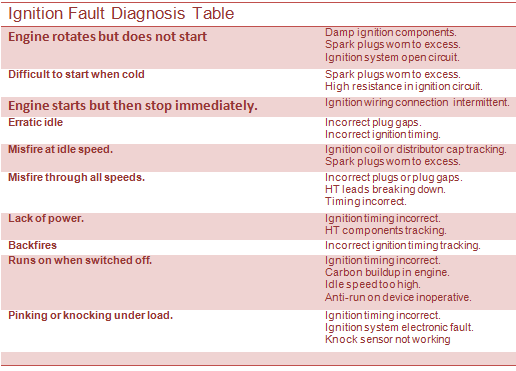The following procedure is generic and with a little adaptation can be applied to any ignition system. Refer to manufacturer’s recommendations if in any doubt.
Ignition systems diagnostic chart.
Ignition Fault Diagnosis.
Ignition timing light.
Typical ignition timing light, essential to ensure correct settings where these are adjustable, or to check programmed advance systems for correct operation.
Ignition components and testing.
DIS diagnostics.
The DIS system is very reliable due to the lack of any moving parts. Some problems can be experienced when trying to examine HT oscilloscope patterns due to the lack of a king lead. This can often be overcome with a special adapter but it is still necessary to move the sensing clip to each lead in turn. The DIS coil can be tested with an ohmmeter. The resistance of each primary winding should be 0.5 and the secondary windings between 11 and 16 k. The coil will produce in excess of 37kV in an open circuit condition. The plug leads have integral retaining clips to prevent water ingress and vibration problems. The maximum resistance for the HT leads is 30 k per lead.
No service adjustments are possible with this system with the exception of octane adjustment on some models. This involves connecting two pins together on the module for normal operation, or earthing one pin or the other to change to a different fuel. The actual procedure must be checked with the manufacturer for each particular model.
Spark plug diagnostics.
Examination of the spark plugs is a good way of assessing engine and associated systems condition.
New spark plug.
Use this image to compare with used spark plugs. Not in particular, on this standard design, how the end of the nose is flat and that the earth/ground electrode is a consistent size and shape.
Carbon fouled (standard plug).
This plug has black deposits over the centre electrode and insulator in particular. It is likely that this engine was running too rich – or on an older vehicle the choke was used excessively. However, carbon fouling may also be due to:
- Poor quality spark due to ignition fault.
- Incorrect plug gap.
- Over retarded timing.
- Loss of cylinder compression.
- Prolonged low speed driving.
- Incorrect (too cold) spark plug fitted.
Deposits.
The deposits on this plug are most likely to be caused by oil leaking into the cylinder. Alternatively, poor quality fuel mixture supply or very short, cold engine operation could result in a similar condition.
Damaged insulation.
A plug that is damaged in this way is because of either overheating or impact damage. Impact is most likely in this case. The damage can of course be caused as the plug is being fitted! However, in this case a possible cause would be that the reach was too long for the engine and the piston hit the earth/ground electrode, closing up the gap and breaking the insulation.
Carbon fouled (platinum plug).
The carbon build upon this plug would suggest an incorrect mixture. However, before diagnosing a fault based on spark plug condition, make sure the engine has been run up to temperature – ideally by a good road test. The engine from which this plug was removed is in good condition – it had just been started from cold and only run for a few minutes.
Overheating.
When a plug overheats the insulator tip becomes glossy and/or they are blistered or melted away. The electrodes also wear quickly. Excessive overheating can result in the electrodes melting and serious piston damage is likely to occur. Causes of overheating are:
- Over advanced ignition.
- Mixture too lean.
- Cooling system fault.
- Incorrect plug (too hot).
- Incorrect fuel (octane low)..








